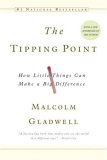Summary | Excerpt | Reviews | Readalikes | Genres & Themes | Author Bio

Critics' Opinion:
Readers' Opinion:
First Published:
Feb 2000, 279 pages
Paperback:
Dec 2001, 304 pages
The Stickiness Factor says that there are specific ways of making a contagious message memorable; there are relatively simple changes in the presentation and structuring of information that can make a big difference in how much of an impact it makes.
3
Every time someone in Baltimore comes to a public clinic for treatment of syphilis or gonorrhea, John Zenilman plugs his or her address into his computer, so that the case shows up as a little black star on a map of the city. It's rather like a medical version of the maps police departments put up on their walls, with pins marking where crimes have occurred. On Zenilman's map the neighborhoods of East and West Baltimore, on either side of the downtown core, tend to be thick with black stars. From those two spots, the cases radiate outward along the two central roadways that happen to cut through both neighborhoods. In the summer, when the incidence of sexually transmitted disease is highest, the clusters of black stars on the roads leading out of East and West Baltimore become thick with cases. The disease is on the move. But in the winter months, the map changes. When the weather turns cold, and the people of East and West Baltimore are much more likely to stay at home, away from the bars and clubs and street corners where sexual transactions are made, the stars in each neighborhood fade away.
The seasonal effect on the number of cases is so strong that it is not hard to imagine that a long, hard winter in Baltimore could be enough to slow or lessen substantially — at least for the season — the growth of the syphilis epidemic.
Epidemics, Zenilman's map demonstrates, are strongly influenced by their situation — by the circumstances and conditions and particulars of the environments in which they operate. This much is obvious. What is interesting, though, is how far this principle can be extended. It isn't just prosaic factors like the weather that influence behavior. Even the smallest and subtlest and most unexpected of factors can affect the way we act. One of the most infamous incidents in New York City history, for example, was the 1964 stabbing death of a young Queens woman by the name of Kitty Genovese. Genovese was chased by her assailant and attacked three times on the street, over the course of half an hour, as thirty-eight of her neighbors watched from their windows. During that time, however, none of the thirty-eight witnesses called the police. The case provoked rounds of self-recrimination. It became symbolic of the cold and dehumanizing effects of urban life. Abe Rosenthal, who would later become editor of the New York Times, wrote in a book about the case:
Nobody can say why the thirty-eight did not lift the phone while Miss Genovese was being attacked, since they cannot say themselves. It can be assumed, however, that their apathy was indeed one of the big-city variety. It is almost a matter of psychological survival, if one is surrounded and pressed by millions of people, to prevent them from constantly impinging on you, and the only way to do this is to ignore them as often as possible. Indifference to one's neighbor and his troubles is a conditioned reflex in life in New York as it is in other big cities.
This is the kind of environmental explanation that makes intuitive sense to us. The anonymity and alienation of big-city life makes people hard and unfeeling. The truth about Genovese, however, turns out to be a little more complicated — and more interesting. Two New York City psychologists — Bibb Latane of Columbia University and John Darley of New York University — subsequently conducted a series of studies to try to understand what they dubbed the "bystander problem." They staged emergencies of one kind or another in different situations in order to see who would come and help. What they found, surprisingly, was that the one factor above all else that predicted helping behavior was how many witnesses there were to the event.
© 2000 by Malcolm Gladwell





The Funeral Cryer by Wenyan Lu
Debut novelist Wenyan Lu brings us this witty yet profound story about one woman's midlife reawakening in contemporary rural China.
Your guide toexceptional books
BookBrowse seeks out and recommends the best in contemporary fiction and nonfiction—books that not only engage and entertain but also deepen our understanding of ourselves and the world around us.